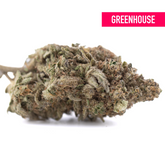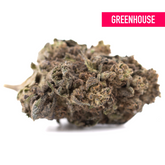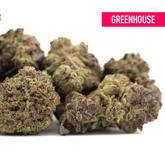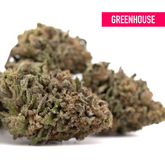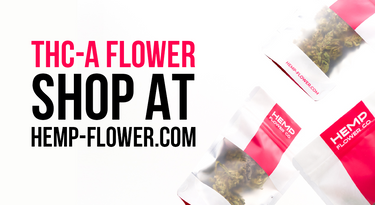Blue Dream THCA: Everything You Need to Know About This Popular Strain

If you're exploring the world of THCA flower, you've likely heard of Blue Dream. This legendary hybrid has captivated cannabis enthusiasts for years, and blue dream thca flower continues to be one of the most sought-after options in dispensaries across the country. Whether you're new to THCA or a seasoned consumer, understanding what makes Blue Dream special can help you make informed choices about your cannabis experience.
In this comprehensive guide, we'll explore everything from the strain's origins and terpene profile to consumption methods and how it compares to other popular varieties. By the end, you'll understand why Blue Dream has maintained its legendary status in the cannabis community and whether it's the right choice for your needs.
What is Blue Dream THCA?
Blue dream thca refers to the raw, unheated form of this popular strain. THCA (tetrahydrocannabinolic acid) is the non-psychoactive precursor to THC that exists naturally in fresh cannabis plants. When you purchase thca blue dream flower, you're getting the plant's natural cannabinoid profile before decarboxylation occurs through the application of heat.
This is an important distinction: THCA flower won't produce intoxicating effects until it undergoes decarboxylation through smoking, vaping, or cooking. The THCA molecule has a carboxyl group attached that prevents it from binding to CB1 receptors in the brain. Only when heat removes this carboxyl group—converting THCA to THC—do the familiar psychoactive effects occur.
Understanding THCA vs THC
The relationship between THCA and THC is crucial for consumers to understand. In the plant, nearly all THC exists as THCA. When you see lab results showing high percentages of THCA, you're looking at the potential THC content once the flower is heated. This means that THCA flower offers the same experiences as traditional THC-rich cannabis—it simply requires activation through heat first.
Many consumers appreciate THCA flower because it exists in a legal gray area in certain jurisdictions where hemp-derived products with less than 0.3% delta-9 THC are permitted. Since THCA technically isn't THC until heated, it can sometimes be sold legally where THC products cannot. However, laws vary significantly by location, so always verify your local regulations.
Strain Background and Genetics
Blue Dream is a sativa-dominant hybrid originating from California, created by crossing Blueberry indica with Haze sativa. This genetic combination delivers the best of both worlds: the relaxing body effects of indica genetics with the cerebral, uplifting qualities of sativa genetics. The strain emerged from the West Coast cannabis scene in the early 2000s and quickly became one of the most recognized and requested varieties worldwide.
The Blueberry parent strain contributes the sweet, fruity flavors and gentle physical relaxation that Blue Dream is famous for. DJ Short originally developed Blueberry by crossing various landrace strains, creating an indica known for its distinctive berry aroma and calming effects. On the other side, the Haze parent brings energizing cerebral effects, creativity enhancement, and an uplifting quality that prevents Blue Dream from becoming too sedating.
This carefully selected genetic background typically results in a ratio of approximately 60% sativa to 40% indica, though this can vary slightly between different phenotypes. The sativa dominance explains why Blue Dream is often described as "daytime-friendly"—it provides relaxation without the heavy sedation that pure indica strains can produce.
Terpene Profile and Aroma
The terpene profile of blue dream thca flower is what truly sets it apart from other strains and contributes significantly to its effects and appeal. Terpenes are aromatic compounds found in cannabis and many other plants that contribute to flavor, aroma, and potentially to the overall effects through what's known as the "entourage effect."
Primary Terpenes in Blue Dream
Myrcene is typically the dominant terpene in Blue Dream, providing earthy, musky notes reminiscent of cloves and ripe fruit. Myrcene is believed to contribute to the relaxing qualities of cannabis and may enhance the absorption of cannabinoids. This terpene also appears in mangoes, lemongrass, and hops, and is associated with calming, sedative-like properties that balance Blue Dream's energizing sativa effects.
Pinene offers a fresh pine aroma that adds complexity to Blue Dream's scent profile. This terpene, found in pine needles, rosemary, and basil, may support alertness and memory retention—qualities that complement Blue Dream's cerebral effects. Pinene's crisp, forest-like quality helps cut through the sweetness and provides an invigorating aromatic experience.
Caryophyllene adds spicy, peppery undertones with potential anti-inflammatory properties. This terpene is unique because it can interact with CB2 receptors in the body's endocannabinoid system. Found in black pepper, cinnamon, and cloves, caryophyllene contributes to the complexity of Blue Dream's flavor while potentially offering therapeutic benefits.
The Complete Aromatic Experience
The result of this terpene combination is a sweet berry aroma with hints of vanilla and herbal earthiness—a scent profile that's instantly recognizable to Blue Dream fans. When you open a container of quality Blue Dream THCA flower, you should immediately notice the prominent blueberry sweetness, followed by undertones of pine and earth. Some batches also display subtle notes of citrus or tropical fruit, depending on growing conditions and phenotype variations.
This aromatic complexity isn't just about enjoyment—it's also an indicator of flower quality. A robust terpene profile suggests proper growing, harvesting, and curing practices that preserve these volatile compounds. Terpenes degrade with exposure to light, heat, and oxygen, so strong aromatics indicate fresh, well-maintained flower.
Effects and Benefits
Users consistently report that Blue Dream offers a balanced experience that combines mental clarity with physical relaxation—a combination that has made it one of the most popular strains for both recreational and wellness-focused consumers.
Cerebral and Mental Effects
The sativa-dominant genetics produce creative and uplifting cerebral effects that many users find ideal for daytime activities. Consumers often report enhanced focus and motivation, making Blue Dream popular among those who want to remain productive while enjoying cannabis. The mental stimulation tends to be smooth and manageable rather than overwhelming or anxiety-inducing, which can occur with more potent sativa-dominant strains.
Many users describe a gentle euphoria that elevates mood without causing racing thoughts or paranoia. This makes Blue Dream an accessible choice for those who find pure sativa strains too intense. The cerebral effects typically onset relatively quickly when smoked or vaped, usually within 5-10 minutes, and can enhance appreciation for music, art, conversation, and creative pursuits.
Physical Effects
Despite its sativa dominance, Blue Dream provides gentle body relaxation without heavy sedation. Users report a pleasant physical comfort that relieves tension without causing the "couch-lock" effect common with indica-heavy strains. This balanced physical sensation allows for continued activity and mobility while still providing the calming body effects that many cannabis consumers seek.
The physical relaxation tends to spread gradually through the body, creating a sense of ease that complements rather than overwhelms the mental effects. This makes Blue Dream particularly popular for social situations, outdoor activities, or creative projects where you want relaxation without sedation.
Duration and Onset
When smoked or vaped, effects typically begin within 5-10 minutes and can last 2-4 hours depending on dosage, individual tolerance, and consumption method. The experience tends to peak around 30-60 minutes after consumption, then gradually tapers off. Many users report that Blue Dream's effects fade gracefully without an abrupt crash, making the come-down period comfortable.
Potential Wellness Applications
While individual experiences vary, users have reported that Blue Dream may offer potential support for:
- Stress and tension relief: The balanced effects can help ease mental and physical stress without impairment
- Mood enhancement: The uplifting qualities may provide temporary relief from low mood
- Discomfort management: Some users report that the gentle body effects help with minor physical discomfort
- Focus and creativity: The cerebral stimulation may enhance concentration for certain tasks
- Social anxiety: The mood-lifting properties without overwhelming intensity can help some users feel more comfortable in social situations
It's important to note that while many consumers report these benefits, cannabis affects everyone differently, and what works for one person may not work for another. Always start with a low dose to assess your individual response.

Consumption Methods
Blue dream thca offers versatility in consumption methods, allowing users to choose the approach that best fits their lifestyle and preferences.
Blue Dream THCA Flower
Traditional smoking or vaporizing flower remains the most popular method for consuming Blue Dream. The flower's quality terpene profile truly shines when properly cured and stored. Smoking via joints, pipes, or bongs provides immediate effects and allows you to control dosage through titration—taking small amounts and waiting to assess effects before consuming more.
When purchasing blue dream thca flower, look for buds that are:
- Dense and well-formed with visible trichome coverage
- Displaying blue and purple hues among the green
- Properly cured—slightly sticky to the touch but not wet or brittle
- Aromatic with the characteristic sweet berry scent
Vaporizing dry flower offers advantages over smoking by heating the material to temperatures that release cannabinoids and terpenes without combustion. This method is generally considered smoother on the throat and lungs while preserving more of the delicate terpene profile. Temperature control allows you to customize your experience—lower temperatures (315-385°F) emphasize terpene flavors and provide lighter effects, while higher temperatures (385-440°F) produce more robust vapor and stronger effects.
Blue Dream THCA Vape
Blue dream thca vape cartridges offer convenience and discretion that flower cannot match. These pre-filled cartridges attach to battery-powered vaporizers and provide consistent, measured doses with minimal preparation or smell. Vaping at lower temperatures (315-440°F) preserves terpenes and provides smoother effects while reducing harshness.
The advantages of vape cartridges include:
- Portability: Easy to carry and use discreetly
- Consistency: Each draw provides similar amounts of vapor
- Cleanliness: No preparation, ash, or lingering smoke smell
- Precision: Many devices allow temperature control for customized experiences
- Efficiency: Vaporization is generally more efficient than combustion
This method is perfect for on-the-go use or situations where discretion is important. However, it's crucial to purchase vape products from reputable sources that provide lab testing to ensure purity and safety.
Other Consumption Methods
Some consumers incorporate THCA flower into edibles after decarboxylation. This process involves heating the flower in an oven (typically 220-245°F for 30-45 minutes) to convert THCA to THC, then infusing it into butter or oil for cooking. Edibles provide longer-lasting effects (4-8 hours) but take longer to onset (45 minutes to 2 hours) and can be more intense and less predictable.
An interesting alternative is consuming raw THCA flower without heating it. Some health-conscious consumers add raw cannabis to smoothies or juices, believing that THCA itself may offer certain wellness benefits without psychoactive effects. However, this method won't produce the traditional cannabis experience since THCA requires heat for conversion to THC.
Growing Characteristics
For cultivators interested in growing their own Blue Dream, this strain is known for being moderately easy to cultivate, making it suitable for intermediate growers while still rewarding experienced cultivators with excellent yields.
Cultivation Overview
Flowering Time: Blue Dream typically requires 9-10 weeks of flowering, which is average to slightly above average for hybrid strains. This moderate flowering period allows growers to harvest multiple crops per year in indoor environments.
Yields: Above average yields are one of Blue Dream's attractive qualities for cultivators. Indoor grows can produce 450-550 grams per square meter, while outdoor plants in optimal conditions can yield 600-800 grams per plant or more.
Height: Blue Dream plants tend to grow tall, displaying the classic sativa structure with greater vertical growth than most indica-dominant strains. Indoor growers often need to employ training techniques like topping, LST (low-stress training), or SCROG (screen of green) to manage height. Outdoor plants can reach 6-10 feet in optimal conditions.
Climate Preferences: This strain thrives in Mediterranean-style climates with warm, sunny days and mild nights. It performs well in both indoor and outdoor environments but shows its full potential when grown outdoors in ideal conditions.
Resistance: Blue Dream demonstrates good resistance to common pests and mold, though its tall, dense colas can be susceptible to bud rot in humid conditions. Proper air circulation and humidity control are essential, especially during the flowering period.
Tips for Optimal Results
Growers should pay attention to nutrient management, as Blue Dream has moderate to high feeding requirements during the vegetative and flowering stages. The strain responds well to both organic and synthetic nutrients but can show nutrient burn if overfed. Regular monitoring and adjustment of pH levels (6.0-7.0 for soil, 5.5-6.5 for hydroponics) help ensure optimal nutrient uptake.
Proper curing after harvest is crucial for developing Blue Dream's signature aroma and smoothness. A slow cure in darkness at 60-65°F with 60-65% humidity for 2-4 weeks allows chlorophyll to break down and terpenes to fully develop, resulting in the sweet, smooth smoke that made the strain famous.

How Blue Dream Compares to Other Popular THCA Strains
Understanding how Blue Dream stacks up against other popular THCA options can help you make informed decisions about which strain best suits your needs.
Blue Dream vs Wedding Cake THCA
While wedding cake thca offers heavy, dessert-like relaxation with sedating indica effects, Blue Dream provides more uplifting, energetic qualities. Wedding Cake, also known as Pink Cookies, is an indica-dominant hybrid created from Cherry Pie and Girl Scout Cookies genetics. It delivers sweet, vanilla, and cake-like flavors with powerful full-body relaxation.
Wedding Cake is better suited for evening use, unwinding after work, or preparing for sleep. Its effects are notably more sedating than Blue Dream, often producing couch-lock at higher doses. In contrast, Blue Dream works well throughout the day and allows for continued productivity and activity. If you're choosing between these strains, consider the time of day and your planned activities—Wedding Cake for relaxation and sleep, Blue Dream for balanced effects that don't interfere with daily tasks.
Blue Dream vs OG Kush THCA
OG kush thca is a classic indica-dominant hybrid known for its earthy, piney, and fuel-like flavor profile and strong relaxing effects. OG Kush has been a West Coast staple since the 1990s and serves as a parent strain for countless popular varieties.
OG Kush provides more intense physical relaxation and sedation compared to Blue Dream's lighter touch. While both strains offer stress relief, OG Kush leans heavily into body effects that can lead to significant couch-lock, especially at higher doses. Blue Dream is lighter and more cerebral, making it better for maintaining productivity, social situations, or daytime use.
The flavor profiles also differ significantly—OG Kush brings earthy, woody, and diesel notes, while Blue Dream emphasizes sweet berries and vanilla. Your flavor preference may influence your choice between these two legendary strains.
Blue Dream vs White Runtz THCA
White runtz thca delivers a candy-sweet flavor profile with balanced hybrid effects. This strain, created from Zkittlez and Gelato genetics, has exploded in popularity due to its dessert-like flavor and attractive appearance featuring vibrant colors and heavy trichome coverage.
While both strains are well-balanced hybrids, White Runtz tends to be slightly more sedating than Blue Dream's sativa-leaning effects. White Runtz provides a creamy, fruity, almost candy-like taste, while Blue Dream emphasizes berry and herbal notes. Both work well for hybrid seekers, but Blue Dream offers more energy and mental clarity, while White Runtz leans slightly more toward relaxation.
The choice often comes down to personal preference regarding effects intensity and flavor profile. White Runtz is also typically more expensive due to its trending status and lower typical yields during cultivation.
Blue Dream vs Gary Payton THCA
Gary payton thca is a potent hybrid created by Cookies and Powerzzz Genetics, crossing The Y with Snowman. Named after the NBA Hall of Famer, this strain is known for its diesel and herbal notes with powerful cerebral effects that can be quite intense.
Gary Payton delivers a much more potent experience than Blue Dream, with higher THC levels and more intense effects that can be overwhelming for novice consumers or those seeking a lighter experience. Blue Dream offers a smoother, more accessible experience with less intensity—perfect for those who find Gary Payton too strong or who want more functional effects.
Gary Payton excels for experienced consumers seeking maximum potency and intense euphoria, while Blue Dream serves a broader audience with its gentle, balanced profile. If you're new to cannabis or prefer moderate effects that allow for daily functionality, Blue Dream is the clear choice. Gary Payton is better suited for evening use or experienced consumers with higher tolerance.
Why Blue Dream Remains Popular
Despite countless new strains entering the market each year—many with exotic names, unique genetics, and impressive cannabinoid profiles—Blue Dream maintains its position as a top choice for consumers worldwide. Several factors explain this enduring popularity:
1. Consistency
The strain's effects are reliable and well-documented across multiple grows, batches, and producers. When you purchase Blue Dream, you generally know what to expect: balanced effects, sweet berry flavor, and moderate potency. This predictability is valuable for both new consumers seeking a reliable introduction to cannabis and experienced users who want consistent results.
2. Versatility
Blue Dream works well for various occasions and times of day. Its balanced profile makes it suitable for morning use to start the day with focus and positivity, afternoon use for creative projects or social activities, and even early evening use for unwinding without heavy sedation. Few strains offer this level of versatility across different contexts and use cases.
3. Accessibility
Blue Dream is widely available at dispensaries and from online retailers, often at reasonable prices compared to trendy or limited-release strains. Its popularity and relatively easy cultivation mean that supply usually meets demand, keeping prices competitive. This accessibility ensures that both budget-conscious consumers and those seeking premium craft options can find Blue Dream that fits their needs.
4. Flavor
The sweet berry taste appeals to a broad audience, including those who dislike the pungent, diesel, or earthy flavors common in many cannabis strains. Blue Dream's pleasant taste makes consumption enjoyable rather than merely tolerable, contributing to positive experiences that encourage repeat purchases.
5. Balance
Blue Dream offers the "best of both worlds" between indica and sativa effects. This balance appeals to the largest possible audience—those who want relaxation without sedation, mental stimulation without anxiety, and mood enhancement without impairment. In an industry increasingly focused on high-THC levels and extreme effects, Blue Dream's moderate, balanced approach remains refreshingly accessible.
6. Cultural Legacy
Beyond its inherent qualities, Blue Dream benefits from strong brand recognition and cultural cachet. It's been referenced in music, featured in cannabis media, and has become a benchmark strain that others are compared against. This cultural significance creates a self-reinforcing cycle where its reputation attracts new users, whose positive experiences perpetuate its legendary status.

What to Look for When Buying
When shopping for blue dream thca flower, quality should be your primary concern. Here's how to identify premium Blue Dream THCA:
Visual Inspection
Appearance: Premium Blue Dream features dense, well-formed buds covered in a thick layer of trichomes that give the flower a frosty, crystalline appearance. Look for blue and purple hues among the green, which result from anthocyanin pigments that develop during cold nighttime temperatures in the final weeks of flowering. The pistils (small hair-like structures) should be vibrant orange or amber.
Structure: Buds should be dense but not overly compressed. Hand-trimmed flower typically shows more care and attention than machine-trimmed flower, with natural shape and minimal damage to trichomes. Avoid flower that appears airy, loose, or poorly formed, as this can indicate premature harvest or poor growing conditions.
Trichomes: Under magnification or close inspection, you should see abundant trichomes (tiny, mushroom-shaped resin glands) covering the flower. These trichomes contain the cannabinoids and terpenes that produce Blue Dream's effects and flavor.
Aroma
Scent Profile: Quality thca blue dream should have a strong, sweet berry scent with herbal undertones. The aroma should be immediately noticeable when you open the container. Weak or absent aroma suggests old flower, improper curing, or poor storage conditions that allowed terpenes to degrade.
Complexity: Beyond the dominant blueberry sweetness, you should detect subtle notes of pine, earth, and vanilla. This aromatic complexity indicates a robust terpene profile that will translate to flavorful consumption experiences.
Lab Testing
Cannabinoid Profile: Reputable sellers provide third-party lab results showing THCA percentages, CBD content, and other cannabinoids. Quality Blue Dream typically shows 15-24% THCA, though this can vary. Be wary of claims of extremely high THCA percentages (30%+) without documentation, as these are uncommon and may be inaccurate.
Terpene Content: Advanced lab results include terpene profiles showing specific terpene percentages. Look for significant levels of myrcene, pinene, and caryophyllene—the characteristic Blue Dream terpenes.
Contaminants: Lab testing should screen for pesticides, heavy metals, mold, and residual solvents (if applicable). Clean results across all categories are essential for safe consumption.
Freshness and Texture
Moisture Content: Properly cured flower should be slightly sticky to the touch but not wet or brittle. Overly dry flower has lost terpenes and will produce harsh smoke. Flower that's too moist can harbor mold or mildew.
Stem Snap Test: When you bend a stem, it should snap cleanly rather than bend, indicating proper cure. However, the flower itself should maintain some flexibility and stickiness.
Packaging: Quality producers package flower in airtight containers or sealed bags that protect it from light and air exposure. Transparent packaging or extended shelf exposure degrades cannabinoids and terpenes over time.
Price Considerations
While price shouldn't be your only consideration, understanding typical pricing helps you identify good value. Premium blue dream thca flower typically falls in the mid-price range—affordable compared to exotic or limited strains but more expensive than budget or trim options. Extremely low prices may indicate inferior quality, old stock, or improper storage.
Storage and Preservation
To maintain the quality of your Blue Dream THCA flower, proper storage is essential:
- Container: Store in airtight glass jars or containers designed for cannabis storage
- Environment: Keep in a cool, dark place away from direct light and heat
- Humidity: Maintain 55-62% relative humidity using humidity packs if needed
- Separation: Store different strains separately to preserve unique terpene profiles
- Duration: Properly stored flower maintains quality for 6-12 months, though terpene degradation begins immediately after harvest
Frequently Asked Questions
What is the difference between Blue Dream THCA and regular Blue Dream?
Blue Dream THCA refers to flower that contains THCA (the acidic precursor to THC) rather than THC itself. When you heat THCA through smoking, vaping, or cooking, it converts to THC and produces the same effects as traditional Blue Dream cannabis. The primary difference is legal status in certain jurisdictions and the form of the cannabinoid before consumption.
Will Blue Dream THCA show up on a drug test?
Yes, consuming Blue Dream THCA will likely result in a positive drug test for THC. When you heat THCA, it converts to THC, which is what drug tests detect. Even if you consume THCA without heating, trace amounts of natural THC present in the flower may trigger positive results. If you're subject to drug testing, you should avoid THCA products.
Is Blue Dream THCA legal?
Legal status varies significantly by location. In some jurisdictions, hemp-derived THCA products containing less than 0.3% delta-9 THC are legal under federal hemp laws. However, many states have specific regulations regarding THCA, and some classify it as a controlled substance equivalent to THC. Always verify your local laws before purchasing or possessing THCA products.
What's the best temperature for vaping Blue Dream THCA flower?
For optimal flavor and terpene preservation, vape Blue Dream flower between 350-390°F (175-200°C). Lower temperatures (315-350°F) emphasize terpene flavors and provide lighter, more cerebral effects. Higher temperatures (390-440°F) produce thicker vapor and more intense effects but may sacrifice some flavor. Experiment within this range to find your preferred balance.
How should I dose Blue Dream THCA if I'm new to cannabis?
Start with 1-2 small inhalations and wait 10-15 minutes to assess effects before consuming more. First-time users should be especially conservative, as individual tolerance varies significantly. Blue Dream's moderate potency makes it relatively forgiving for beginners, but starting low ensures a comfortable experience. You can always consume more, but you can't consume less once effects begin.
Can I use Blue Dream THCA during the day?
Yes, Blue Dream's balanced sativa-dominant profile makes it one of the best strains for daytime use. Its uplifting cerebral effects and gentle body relaxation typically don't cause sedation or couch-lock, allowing most users to remain productive and functional. However, individual responses vary, so assess your personal reaction before using it during important activities.
How does Blue Dream THCA smell, and will it be noticeable?
Blue Dream has a distinctive sweet berry aroma with herbal and vanilla notes. The smell is noticeable but generally less pungent than diesel or skunk-type strains. When smoked or vaped, the odor dissipates relatively quickly compared to more pungent varieties. For maximum discretion, consider vaping over smoking and using odor-control measures if needed.
How long do Blue Dream THCA effects last?
When smoked or vaped, effects typically begin within 5-10 minutes, peak around 30-60 minutes, and last 2-4 hours total. Duration varies based on dosage, consumption method, individual metabolism, and tolerance. Edibles made with decarboxylated Blue Dream THCA will last significantly longer (4-8 hours) but take longer to onset (45 minutes to 2 hours).
Can I grow Blue Dream from THCA flower?
No, you cannot grow new plants from purchased THCA flower, as the flower doesn't contain viable seeds unless specifically pollinated during growth. To grow Blue Dream, you need seeds or clones from a vegetating plant. Many seed banks offer Blue Dream genetics for home cultivation where legally permitted.
What makes Blue Dream different from other berry-flavored strains?
While several strains feature berry notes, Blue Dream's specific genetic combination produces a unique flavor profile that balances sweet blueberry with vanilla, pine, and herbal earthiness. Additionally, its effect profile—energizing yet relaxing—distinguishes it from purely indica berry strains that tend toward sedation. The combination of flavor and balanced effects makes Blue Dream uniquely accessible and versatile.
Final Thoughts
Blue Dream THCA remains a staple in the cannabis community for excellent reasons. Its balanced effects, pleasant flavor profile, and versatility make it an excellent choice whether you're just starting your THCA journey or you're a connoisseur seeking a reliable daily strain. The combination of uplifting cerebral effects and gentle physical relaxation creates an experience that satisfies a remarkably broad range of preferences and use cases.
Whether you prefer traditional flower for its robust terpene profile or the convenience of a blue dream thca vape, this legendary strain continues to deliver the quality experience that made it famous. Its enduring popularity isn't due to marketing hype or temporary trends—Blue Dream has earned its reputation through consistency, quality, and the positive experiences of countless consumers over nearly two decades.
In a market increasingly focused on novelty and extreme potency, Blue Dream's moderate, balanced approach offers a refreshing alternative. It proves that sometimes the classics become classics for valid reasons: they simply work well for most people most of the time. The strain's accessibility makes it ideal for newcomers, while its quality and reliability satisfy experienced consumers who appreciate consistency over chasing the latest trend.
As you explore THCA options and compare Blue Dream to alternatives like wedding cake thca, og kush thca, white runtz thca, or gary payton thca, consider your personal preferences regarding effects intensity, flavor profile, and intended use case. Each strain offers unique characteristics, but Blue Dream's balanced nature makes it a safe bet for most situations.
As always, start with a small amount to assess your individual tolerance and response, and purchase from reputable sources that provide comprehensive lab testing. The enduring popularity of Blue Dream is a testament to its quality—and once you try it, you'll understand why it's remained a favorite for so many years. Whether you're seeking creative inspiration, social lubrication, stress relief, or simply an enjoyable cannabis experience, Blue Dream delivers a reliable, pleasant experience that lives up to its legendary reputation.
